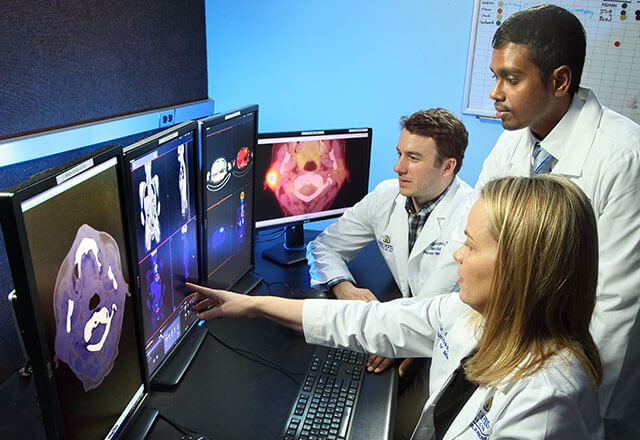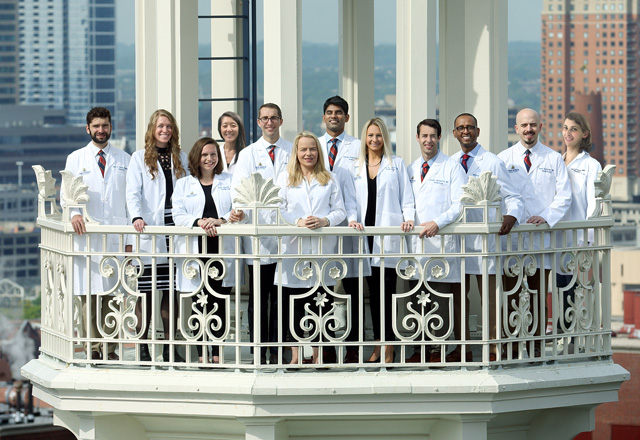How Long Is Residency For Internal Medicine

No. 1 nuclear medicine residency programme in the country, ranked by Doximity and U.S. News and Globe Report.
The Johns Hopkins Nuclear Medicine Residency Preparation program is an ACGME-accredited program. It provides high quality preparation by kinesthesia experts in the field, prepares residents for hereafter clinical and bookish practice and qualifies trainees to sit down for the American Board of Nuclear Medicine certification test.
The length of training required depends on the resident's prior training. A three-year program is required for incoming residents whose prior grooming includes one year of ACGME-approved residency preparation. Those who have completed some other not-imaging residency (e.g., internal medicine, surgery, pediatrics) can complete their nuclear medicine grooming in a 2-year plan. Those with prior training in an ACGME-approved radiology residency are required to take only a one-year plan.
Plan Benefits
Resident Experience
Many of our residents have completed a prior residency (e.g., in radiology, cardiology, neurosurgery, etc.) although some have had only one twelvemonth of ACGME residency preparation. Many of our residents also have Ph.D.south and considerable research feel. Afterwards grooming, a number of our residents have gone into academia, while some go to private do. In recent years, others have taken farther advanced training, including PET/CT fellowships, T-32 NIH research grant positions or radiology residencies.
Expert Faculty
The programme has a strong clinical and basic science teaching program in all areas of diagnostic and therapeutic nuclear medicine. Our faculty includes national and world experts in various subspecialty areas of nuclear medicine and has considerable experience in teaching and research. Johns Hopkins University is recognized as one of the most prestigious and well-known medical centers in the United States. We feel that our residency is one of the strongest nuclear medicine training programs in the nation.
Educational Opportunities
-
During the summer months, residents attend an introductory lectures serial covering relevant principles of nuclear physics and instrumentation, radiochemistry and radiopharmacology and the rationale and technical details of current diagnostic procedures. This course is intended to both fix the inferior resident for clinical responsibilities and refresh and increment the knowledge of senior residents. During the remainder of the bookish year, didactic lectures are given by faculty members approximately three times per week.
-
Residents are actively involved in daily clinical conferences inside the nuclear medicine sectionalization, attended past residents, fellows, faculty and researchers. These conferences include:
- Clinical Case Follow-up Conference
- PET/CT Instance Conference
- Pediatric Radiology/Nuclear Medicine Briefing
- Quality Assessment Conference
- Protocol Review
- Periodical Guild
Residents are gratis of clinical responsibilities during pedagogy hours, unremarkably from 7:30 a.1000. to nine a.m. and noon to 1 p.m.
Residents take the opportunity to attend a multitude of multidisciplinary tumor boards held at The Johns Hopkins Hospital, translational research conferences and departmental grand rounds.
-
Residents usually alternate on one-calendar week rotations to proceeds feel in the various disciplines of nuclear medicine. Rotations include: Inpatient Nuclear Medicine, Outpatient Nuclear Medicine, PET/CT, Nuclear Cardiology, Pediatric Nuclear Medicine, Therapy (radioiodine and parenteral administration), CT and radiopharmacy.
A cardinal goal of clinical preparation in the nuclear medicine program is to enable the resident to take full responsibility for diagnostic and therapeutic studies performed on his/her service. This involves:
- Assessing the clinical problem to be answered (nautical chart review, personal history and fifty-fifty physical test)
- Evaluating the potential role of radionuclide procedures on the diagnostic process and ensuring that the patient receives the correct study
- Assessing the technical quality of images and attempting to reply the clinical question as completely equally possible earlier discharging the patient from the Nuclear Medicine Division
- Interpreting the study with the supervision of the kinesthesia
For the first several months, inferior residents in the clinic work in tandem with a senior resident and a faculty member nether progressively diminishing direct supervision. Withal, attending faculty members are responsible for supervision based on the experience of the resident and are e'er available for consultation, questions and discussions. The experienced resident participates in the training of less-experienced residents likewise every bit of medical students and nuclear medicine technologists, discusses results with referring clinicians and has the opportunity to present interesting/challenging cases to colleagues and kinesthesia at clinical conferences.
The radiopharmacy rotation provides an opportunity to feel the synthesis and quality-control procedures of many of the clinically used radiopharmaceuticals that residents will encounter. Additionally, a quality-control rotation provides feel in the duties of the nuclear medicine technologist, offer the opportunity to learn virtually radiotracer assistants, image conquering/processing, image quality control and in vitro procedures.
-
During training, residents are exposed to the type of enquiry that is existence conducted by senior faculty, other trainees, graduate students and other members of the Johns Hopkins customs in diverse specialties. Trainees are encouraged to pursue any relevant line of research that excites their interest, and opportunities for collaboration both inside and outside the department are vast.
The trainee's research is guided by frequent consultation with members of the kinesthesia, peculiarly with a kinesthesia mentor in his/her area of interest. In add-on, the trainee may nowadays seminars at regular intervals, at which time the entire faculty reviews his/her progress. Residents accept the opportunity to present their work at national meetings, such equally the Society of Nuclear Medicine and Molecular Imaging and Radiological Society of North America.
How to Use
The Nuclear Medicine Residency Grooming plan welcomes trainees of whatever race, color, gender, religion, age, national or ethnic origin or with disabilities. For acceptance into the residency, candidates should have successfully completed one year of an ACGME-accredited residency.
Applications should include:
- Completed application class
- Moving picture (appreciated but non required)
- CV
- Personal statement
- 3 letters of recommendation
- Medical school transcript
- USMLE transcript
- ECFMG certificate (if applicative)
For more information or questions:
History of the Training Program

In 2004, the program increased the number of residency positions from two to six, and in 2007, from half-dozen to nine. With few exceptions, all of the residency positions accept been filled. The plan has ever had a high faculty-to-resident ratio.Harvey Ziessman, Thou.D., author ofNuclear Medicine: The Requisites, was the residency program manager from 2006 to 2015. Earlier joining the Hopkins faculty, he was the residency plan manager from 1991 to 2003 at Georgetown University.
From 2015-2017,Lilja Solnes, M.D., M.B.A. has directed the Nuclear Medicine residency program. From, 2018- 2020 ,A. Cahid Civelek, 1000.D. has directed the Nuclear Medicine residency program. In 2020,Dr. Reema Goel took over as plan director.
The Johns Hopkins University Nuclear Medicine Residency has been ACGME accredited since 1974.Henry Wagner Jr., One thousand.D., likely the most well-known nuclear medicine physician in the world, was the division manager for most xxx years.Richard Wahl, M.D., a distinguished teacher, researcher and clinician, served every bit the division director from 2001 to 2015. The electric current division managing director,Martin Pomper, Grand.D., Ph.D., is an internationally renowned leader in Molecular Imaging.
For more information or whatsoever questions nearly the nuclear medicine residency or fellowship programs, delight contact:
Sasha Waln
Residency and PET/CT Fellowship Program Coordinator
Telephone: 410-955-8449
Email: swaln1@jhmi.edu
Source: https://www.hopkinsmedicine.org/radiology/education/residency/nuclear-medicine-residency-program/
Posted by: vogelsaind1971.blogspot.com

0 Response to "How Long Is Residency For Internal Medicine"
Post a Comment